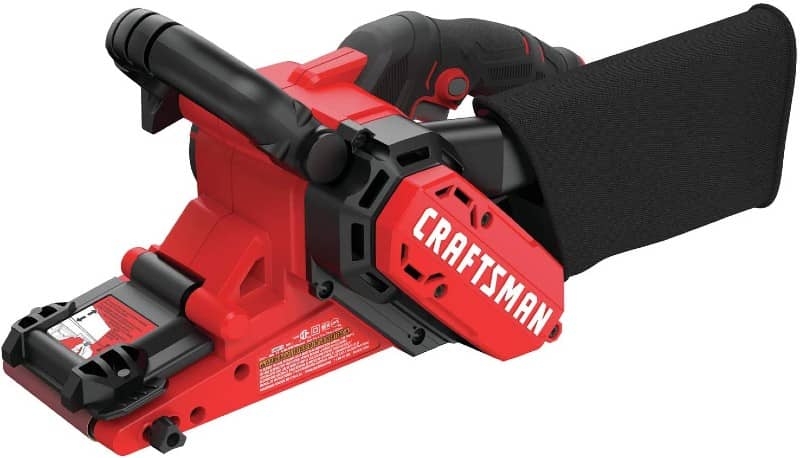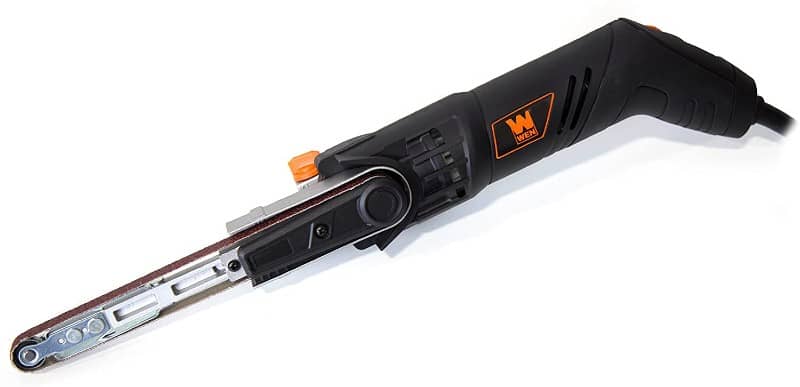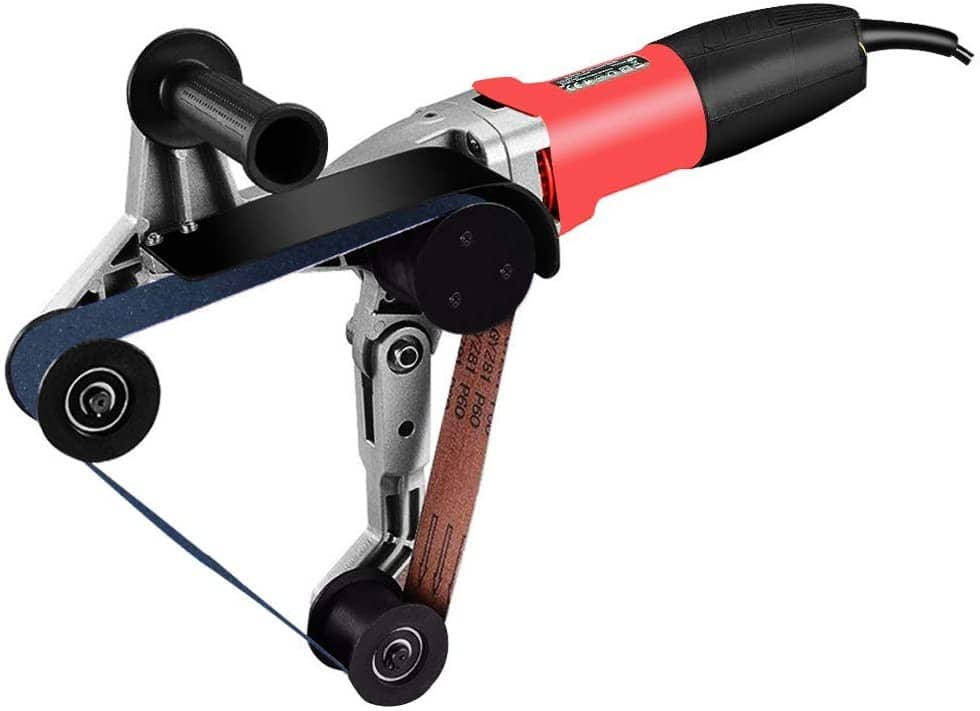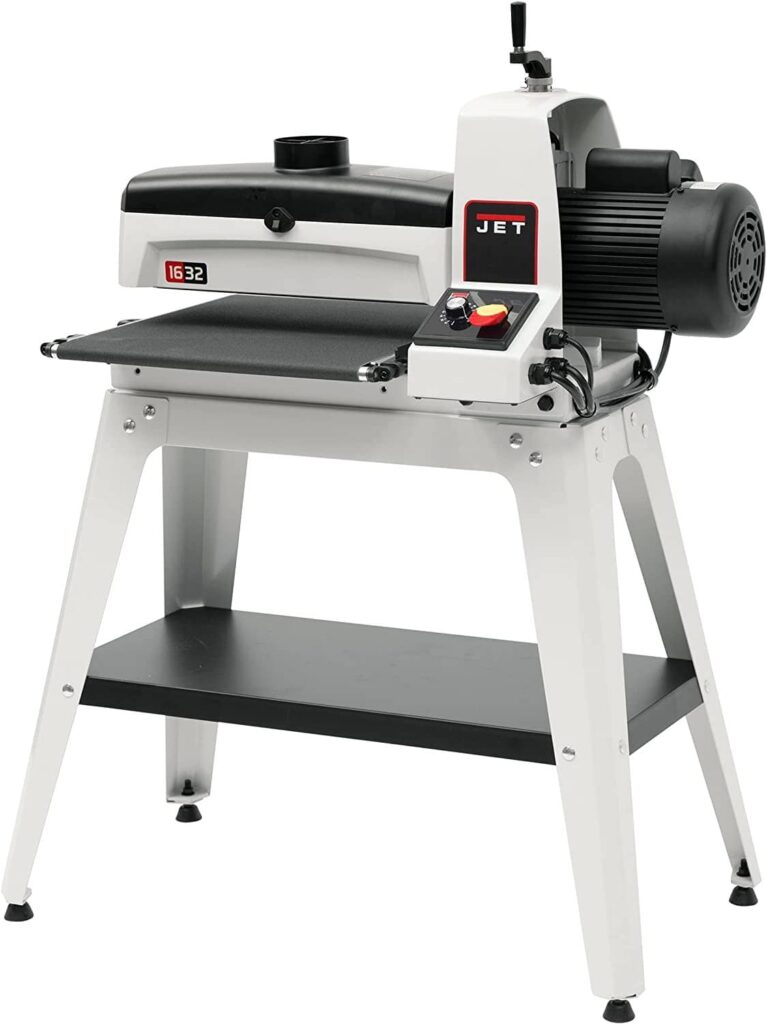Whenever you are considering sanding work, you wind up with a variety of tools. Two of the most popular tools that make sanding easy are belt sanders and drum sanders. Now, choosing one of them for your projects is where you face a bit of trouble.
To help you out with that, I bring you a comparison of belt sander vs. drum sander. Going through the comparison will help you decide which sander works best for your needs.
So, let’s not waste any time and get going with it.
Belt Sander
A belt sander is a wood sanding tool that you can find in portable sizes also in mounted setup. They usually have a belt with sanding paper that starts rolling at great speed when turning on the sander.
Belt sanders maybe of handheld or table top. Hand held belt sanders are small & lightweight where table top sanders are large is size & heavy.
Now, let’s go through some of the benefits you get from a belt sander over any other sander.
- A belt sander helps you smoothen the edges of rough surfaces.
- You can use a belt sander to polish some metals.
- They are a bit smaller in size, which gives them an aspect of portability
- Belt sanders are great for DIY projects
- They are pretty easy to use without having prior experience
- You can reach challenging corners using belt sanders
Well, these are the general benefits you get from any belt sander out there. Several types of belt sanders come with additional benefits. They also have their particular purposes that help you suit different scenarios.
Also Read Our Blog
Types Of Belt Sanders
There are two basic types of belt sanders. You either get a stationary belt sander, or you get a portable belt sander. There are a lot of varieties in the portable belt sander options.
Let’s check them out a little.
Handheld Belt Sander

This is the perfect sanding tool for home and DIY projects. It’s a belt sander that you can carry in your hand and work with it. It’s great for reaching tough places and working portably.
File Sanders

File sanders are great sanding tools to give your projects those finishing touches. They can reach the narrowest of places for sanding work.
Floor Belt Sander
Floor belt sanders aren’t as portable as the other two, but they are great for working on wooden floors. You push the machine on your floor, and it keeps sanding.
Tube Belt Sander

This belt sander is something you can particularly use in polishing pipes. This usually comes in a pulley system which you can move around to polish the pipes properly.
Now, all these portable sanders are pretty much for different purposes. So, which one you get mainly depends on where you want to use that.
They are suitable for some light to medium sanding work. But if you need to do powerful sanding, then you will need a stationary belt sander.
Pros
- They are compact
- These have lightweight options
- There are different sanders for different purposes
- You can access tough to reach areas with this
- Works great for removing material
- You can get quicker results on smaller surfaces
- It doesn’t make too much noise
- They aren’t that expensive
Cons
- Not suitable for heavy projects
- They aren’t suitable for professional usage
Drum Sander

A drum sander is pretty much like a planer in terms of looks. It’s pretty large and, of course, a stationary sander. This sander is used for heavy-duty sanding.
You get a much larger size of sandpaper rolled around the drum. The kind of sanding you get from drum sander is pretty aggressive.
There are several benefits you get from using a drum sander. Let’s check them out one by one.
- These sanders come with great power for some heavy sanding work
- The sanding results you get are pretty efficient and smooth
- Drum sanders are usually very much durable and heavily built
- You can sand on heavy projects within the least amount of time
- Using a drum sander gives you consistent sanding results
When it comes to variety, you will generally get to see two types of drum sanders out there. Let’s go through them a little bit.
Types of drum sander
There are two basic types of drums sanders out there. You get either an open drum sander or a close drum sander.
Open drum sander:
The drum on an open drum sander usually stays suspended. This allows the sander to pass over different broad objects. You also get to see conveyor belts on an open drum sander.
Closed drum sander:
This is the kind of drum sander where both ends of the sander are closed. This makes the width a bit limited, and you can only fit stocks that are processed to fit the width. So, you can work with smaller pieces using a closed drum sander.
You have to choose one of these based on your projects. If you are working with processed wood, then you can use the closed drum sander. Otherwise, you will need to use an open drum sander.
Pros
- They work perfectly for heavy projects
- The belt size is pretty wide for covering larger surfaces
- The belt calibration is much easier and sorted
- It comes with a pretty aggressive sanding action
- Suitable for professionals
- Works perfect for flooring work
Cons
- They can be expensive
- These are pretty noisy
- You can’t carry and move them around easily
- Power usage
Difference Between Belt Sander & Drum Sander
Now, let’s get started with the differences between a belt and a drum sander. Some obvious ones have a huge impact on the performance of their usage.
Usage purpose
The difference between the sanders is pretty evident when you consider the usage. A belt sander works better when you have to remove some material from your projects and do light-duty sanding. It’s the best option for DIYers.
As for heavy sanding projects, drum sanders are the best options to go with. Professionals will get the most use out of this.
What Grit Sandpaper to Use?
For the grit size, it’s pretty straightforward; the higher the grit, the finer it gets with the sandpaper. If you are to work with a drum sander, then you will need a lower grit.
For example, a grit from somewhere around 60 to 120 grit works the best.
With the belt sander, it can go pretty diverse. You can start with a lower grit, and you can use a higher grit for the finishing touches.
So, the range can start from 80 to 350 grit.
NWFA Recommendations
The NWFA recommendations for working on the wood are pretty different based on projects. Usually, for larger projects, you have to start with 36.
Then you have to do a second pass with the 60 grits. Then the final sanding has to be done with 100 nerves. Considering all these, you will find the drum sanders best for your needs.
Coming to the power usage of the sanders, you can already guess how it’s going to be. You will need a lot more power for a drum sander than a belt sander.
However, some powerful belt sanders can require more power.
Usually, the power you need to use these sanders is around 1000w.
Size and Construction
As for the size and construction of the sanders, drum sanders are very heavy and large. They come with heavy-duty metal construction. With the belt sanders, you get different sizes, but they are generally smaller than drum sanders.
Also, they tend to have a lighter weight.
So, these are the differences between the two types of sanders. You can easily tell by going through them that the usability of these two sanders is different. Which one you need for your needs won’t be challenging to choose.
Which One To Choose For & Why
Now, aside from their differences, you can also choose them based on your projects. Specific sanders work great for certain purposes.
Let’s check out which one you should use for what purpose.
Hardwood floor sanding
Typically, a drum sander works better for hardwood floor sanding because they are much more powerful and have an aggressive sanding action that works well for hardwood floors.
Although, you can still use belt sanders if the floor doesn’t require that kind of aggressiveness.
DIY Projects
Without any questions, belt sanders work best for DIY projects. They are compact, lightweight, and easy to work with. As a result, they suit those light projects more than DIYers deal with.
Furnisher sanding
When you are sanding furnisher drum sanders can be a bit overpowering. Because of that, a moderately powered belt sander works the best for furnisher sanding.
Wood bar sanding
You will need to have a finer grit for wood bar sanding, which makes the belt sander a better choice. However, you can also use a drum sander if the wood bar is large enough.
Door and window
When you are working with doors and windows, drum sanders can yield some impressive results because they are much more aggressive in the sanding action.
Tabletop
A belt sander works much better for tabletop sanding because you can use a handheld belt sander and use to sand a tabletop pretty easily. At the same time, you can’t use the drum sander for sanding a tabletop at all.
Conclusion
To sum up, you can’t choose a sander based on which one is the best. You will need the drum sander for some projects, and for some projects, you will need a belt sander.
In fact, in some projects, you may even need both sanders. While you can use the drum sander to cover the larger areas, you can use the belt sander for finer finishing

I am Imtiaj Islam. I am a wood working enthusiast, having 6 years of experience in carpentry work. I have a BBA graduate degree from Chittagong College. I got vocational training on wood works from Korean Polytechnic out of the quest and zest he has for carpentry as well. I take several wood projects and keep testing different woodworking tools for comfortable and perfect work. I just love playing with woods and machines.
